Hawks are widely distributed birds of prey in the order Falconiformes. They all have different behaviors, habitats, shapes, sizes, and colors. There are about 270 species of hawks globally — all classified as raptors or birds of prey.
Hawks are powerful birds. They have sharp and curved talons for catching prey and hooked beaks for tearing it. They also have an excellent sense of hearing and one of the best eyesight capabilities in the entire animal world. Their visual acuity is eight times that of humans.
Hawks thrive in coastal regions, mountains, grasslands, savannas, forests, prairies, and marshes. Whether you’re driving, hiking in the woods, or relaxing in your backyard, getting a chance to see a hawk is always a lot of fun. Here’s a glimpse at eight of them that can be seen in New Jersey:
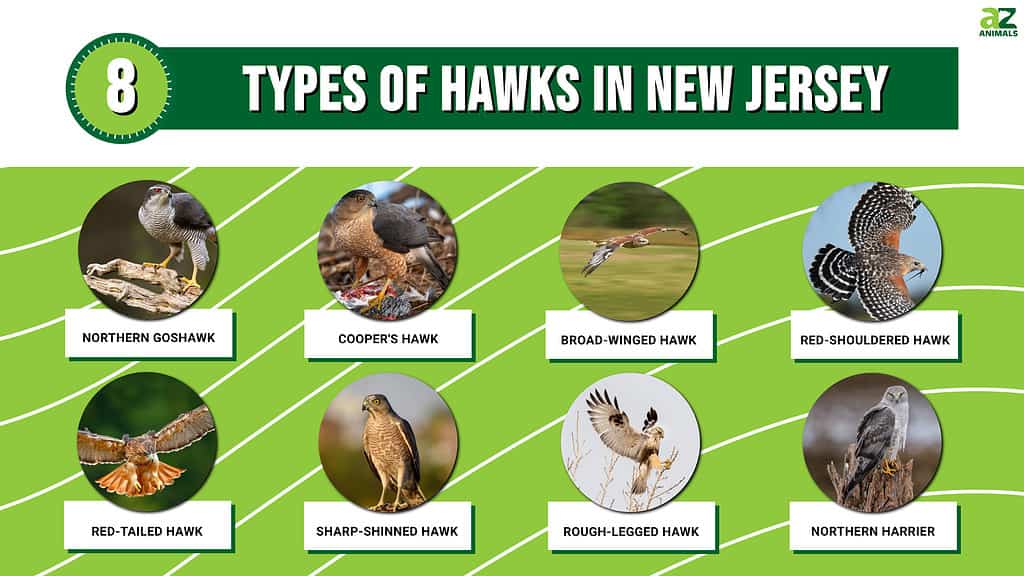
In this article, we describe these hawks in New Jersey and tell you where to find them. Read on!
1. Northern Goshawk
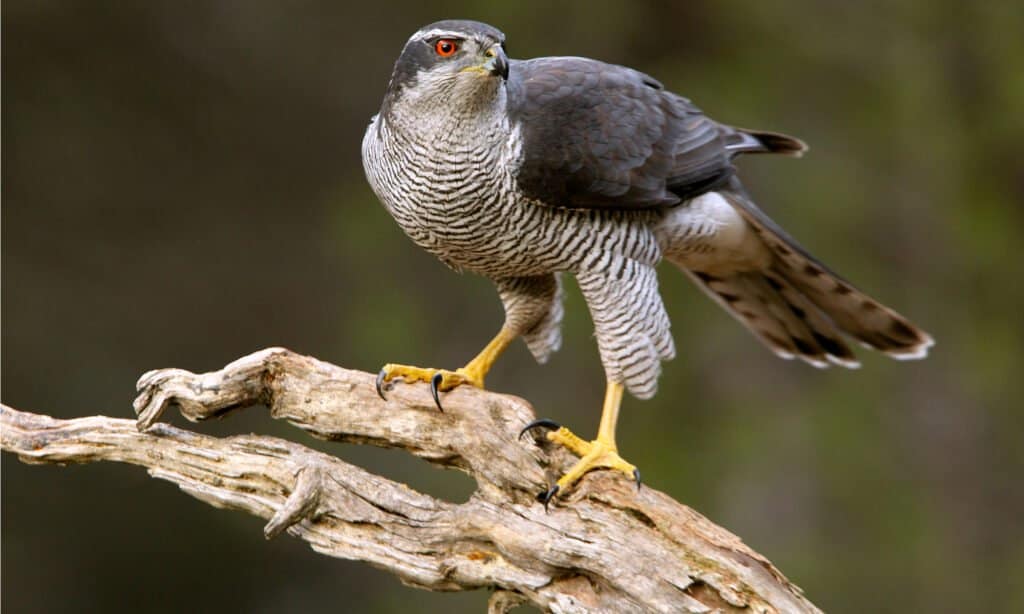
The northern goshawk’s diet consists mainly of rabbits, doves, crows, squirrels, wood pigeons, and other birds.
©Jesus Giraldo Gutierrez/Shutterstock.com
| Northern Goshawk | |
|---|---|
| Scientific name | Accipiter gentilis |
| Color | Brown, grey, red, black, and white |
| Weight | 1.4-4.8 lbs (635-2177 g) |
| Height | 18-27 in (46-69 cm) |
| Wingspan | 40-46 in (103-117 cm) |
The northern goshawk is a wilder, fiercer, and bigger bird of prey that belongs to the family of eagles. Northern goshawks are often spotted during winter in New Jersey. They live in the deepest parts of the forests, where they cannot be traced. They are very secretive birds that can also be aggressive when confronted.
These birds have a diet consisting mainly of rabbits, doves, crows, squirrels, wood pigeons, and other birds. They are predominantly carnivores. The northern goshawk prefers to watch for prey from some of the tallest perches in coniferous or mixed forests.
Northern goshawks are very territorial birds who like guarding or defending areas they consider to belong to them. Females lay between two and five eggs per season, and they are in charge of incubation.
An adult northern goshawk has very few predators in the wild. Nestlings and juveniles are often hunted by other eagles, wolves, and owls.
2. Cooper’s Hawk

A Cooper’s hawk is a medium-sized bird of prey that spends most of its time at the edge of the forest.
©Aussiemandias/Shutterstock.com
| Cooper’s Hawk | |
|---|---|
| Scientific name | Accipiter Cooperii |
| Color | Brown, grey, white |
| Weight | 7.8-14.5 oz (220-410 g) |
| Height | 14-20 in (35-50 cm) |
| Wingspan | 24-39 in (62-99 cm) |
Cooper’s hawks are medium-sized birds of prey that spend most of their time at the edge of the forest, where they can easily ambush elusive prey species. They are very similar to the northern goshawk and sharp-shinned hawk. It can be hard to distinguish them as they all have the same black-banded tail feathers, red-orange breasts, and blue-gray back.
Cooper’s hawks have a diet that consists mainly of quails, plump fowl, chickens, and smaller mammals. These birds often spend many hours in woodland canopies waiting for prey. Their camouflaged feathers aid their hunting style as it conceals them among the tree branches. They prefer taking prey by surprise rather than engaging in a lengthy pursuit of the prey that keeps their distance for quite some time.
Generally, Cooper’s hawks’ predators only comprise eagles and other larger prey birds. Their only major threat is the widespread use of pesticides, which has destroyed thousands of hawks and other predatory animals.
Cooper’s hawks only stick to one mate per season. Females lay 2-6 blue or bluish-white eggs.
3. Broad-winged Hawk
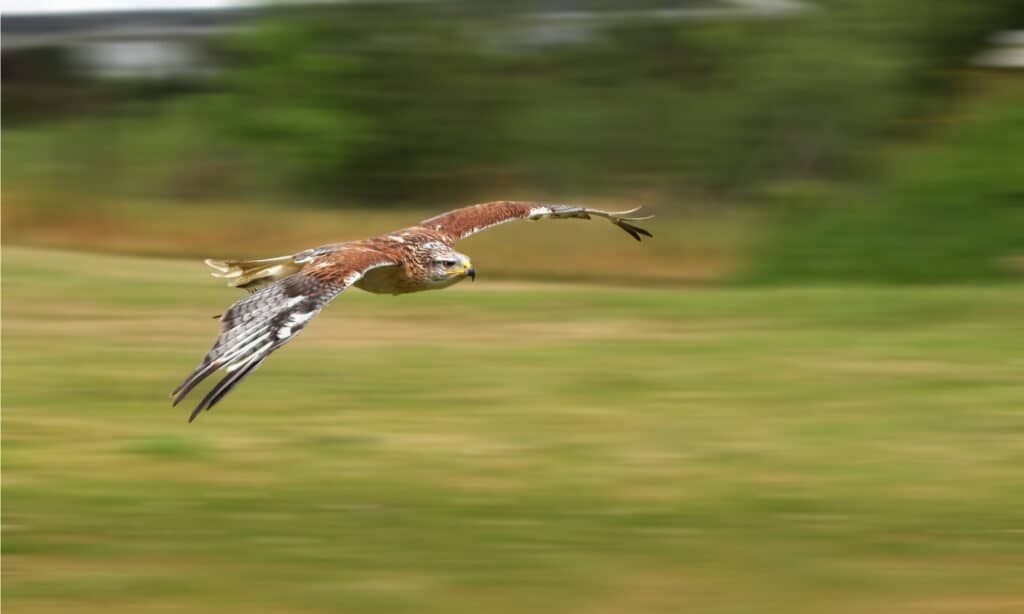
Broad-winged hawks are medium-sized birds of prey with compact, stocky bodies like those of geese and crows.
©pr2is/Shutterstock.com
| Broad-winged Hawk | |
|---|---|
| Scientific name | Buteo platypterus |
| Color | Black, white, reddish-brown |
| Weight | 9.3-19.8 oz (264-561 g) |
| Height | 13.4-17.3 in (34-44 cm) |
| Wingspan | 31.9-39.4 in (81-100cm) |
Broad-winged hawks live throughout New Jersey, though it’s hard to spot them since they prefer living in the deep woods. Fall is the best time to see them when they are migrating in large numbers.
Broad-winged hawks are medium-sized birds of prey with compact, stocky bodies like those of geese and crows. Their diet mainly consists of snakes, lizards, young turtles, frogs, and other small mammals.
Adult broad-winged hawks can sometimes prey on other hawks, eagles, and great horned owls. Their other biggest threats also include collisions with vehicles, poisoning, hunting, and habitat destruction.
Broad-winged hawks are ready to begin breeding when they are around two years of age. Females lay 2-3 eggs, which are white with brown markings. Both parents take care of the nest and young ones from potential predators.
4. Red-shouldered Hawk
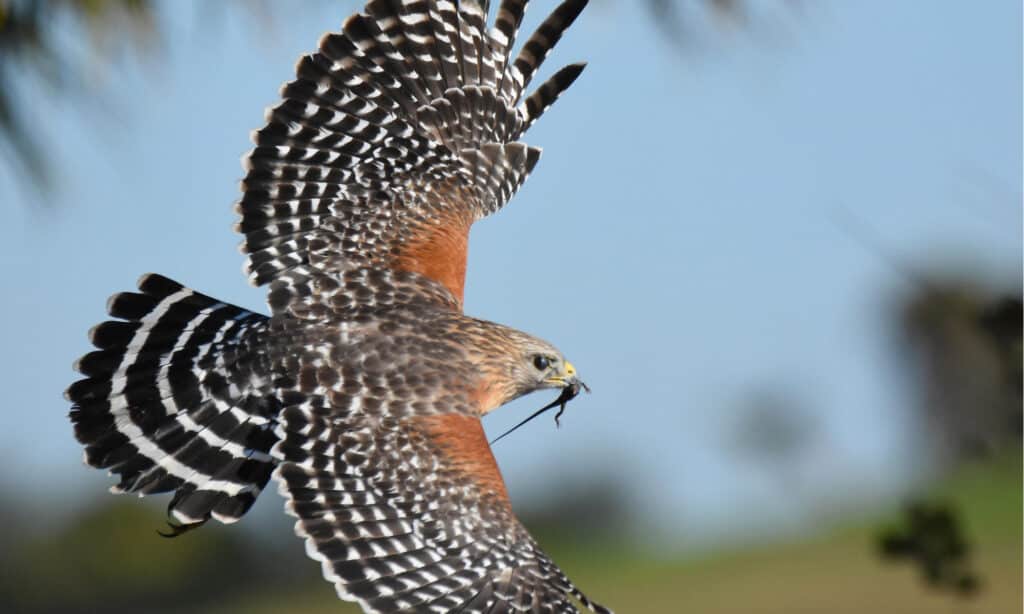
Red-shouldered hawks prey on reptiles, rodents, rabbits, crayfish, amphibians, and other small mammals.
©MTKhaled mahmud/Shutterstock.com
| Red-shouldered Hawk | |
|---|---|
| Scientific name | Buteo lineatus |
| Color | Dark, white, red |
| Weight | 1-1.7 lbs (486-774 g) |
| Height | 15-24 in (38-61 cm) |
| Wingspan | 35-50 in (90-127 cm) |
Red-shouldered hawks are often spotted in New Jersey throughout the year. They are unique hawks with peculiar dark-white checkered wings. They live near wet forests because they like hunting along ponds, swamps, or streams. These birds prefer to hover high along the coasts and ridges.
Red-shouldered hawks prey on reptiles, rodents, rabbits, crayfish, amphibians, and other small mammals. However, humans, snakes, peregrine falcons, martens, and fishers prey on red-shouldered hawks.
These birds are monogamous, and they start breeding once they are two years old. Female red-shouldered hawks lay 2-5 white or bluish eggs. The female broods the eggs continuously for a week, while the male is responsible for providing the food.
5. Red-tailed Hawk
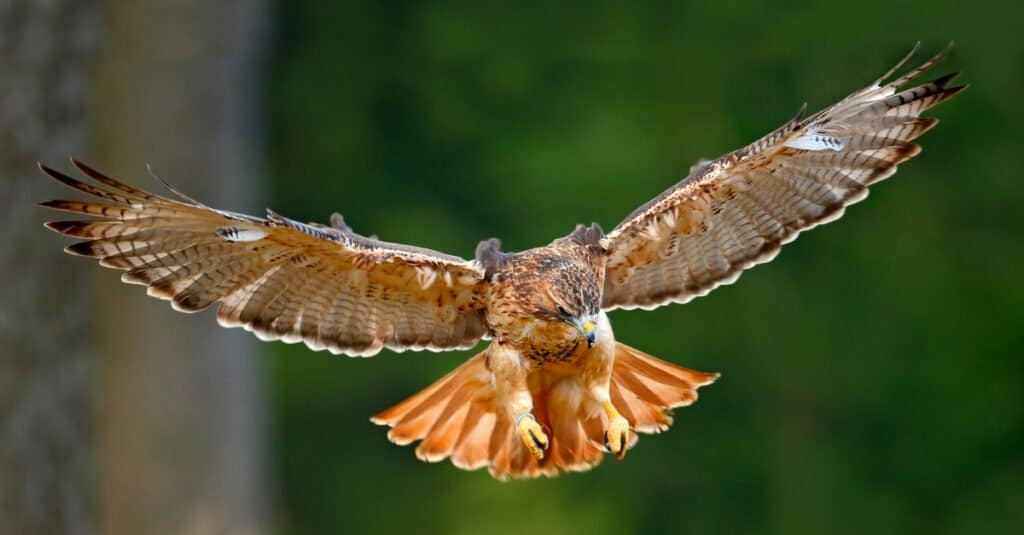
The best place to see red-tailed hawks is in an open field, where they spend most of their time circling in search of prey.
©Ondrej Prosicky/Shutterstock.com
| Red-tailed Hawk | |
|---|---|
| Scientific name | Buteo jamaicensis |
| Color | Brown, pale, cinnamon-red, and dark |
| Weight | 1.5-3.5 lbs (680-1586 g) |
| Height | 18-26 in (45-65 cm) |
| Wingspan | 43-56 in (110-141 cm) |
Red-tailed hawks are commonly seen in New Jersey all year. You can find them almost everywhere since they are comfortable in any habitat. The best place to see red-tailed hawks is in an open field, where they spend most of their time circling in search of prey.
As the name suggests, they have a very distinctive short and wide red tail. They also have a brown back and pale underneath with a streaked belly. Their wings are large and rounded like those of a goose.
Red-tailed hawks have a specialized diet that reflects the niche ecosystem they are located in. They feed on moles, ground squirrels, rabbits, small raccoons, mice, and voles. Great-horned owls and bobcats often prey on red-tailed hawks.
Red-tailed hawks build their nests on top of the tallest buildings, cliff ledges, and tallest trees. Females lay between 2-3 whitish, brown blotched eggs.
6. Sharp-shinned Hawk
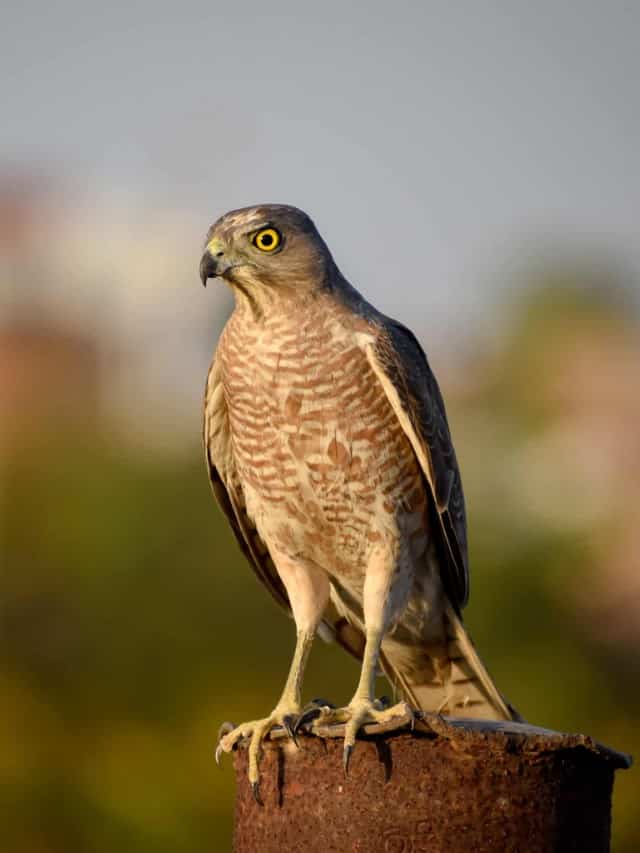
Sharp-shinned hawks inhabit the deepest ends of the forests and can be sighted only in open habitats during migration.
©Vizz Effect/Shutterstock.com
| Sharp-shinned Hawk | |
|---|---|
| Scientific name | Accipiter striatus |
| Color | Blue-gray, red-orange, brown, and dark |
| Weight | 2.9-7.7 oz (82-219 g) |
| Height | 9.1-15 in (23-37 cm) |
| Wingspan | 17-27 in (42-68 cm) |
Sharp-shinned hawks are among the most common hawks in New Jersey. They are small, long-tailed hawks with round wings and square-tipped tails. They have tiny heads that are hardly visible when they are up in the sky. Female sharp-shinned hawks are bigger than males.
Adult sharp-shinned hawks are grayish-blue on top with red-orange breasts. Their young ones are brown with broad dark bands across their tails, just like adults.
Sharp-shinned hawks can fly at a very high speed through dense forests to surprise prey. They have an outstanding flap-and-glide flight style. Their diet consists mainly of small birds like songbirds and quails. They also feed on large insects, snakes, frogs, squirrels, and rodents.
Sharp-shinned hawks inhabit the deepest ends of the forests and can only be sighted high in the sky or in open habitats during migration. They build their nests in conifer trees, usually on top of the tallest trees with dense cover. Females lay between 3 and 8 white or pale-blue mottled eggs.
7. Rough-legged Hawk
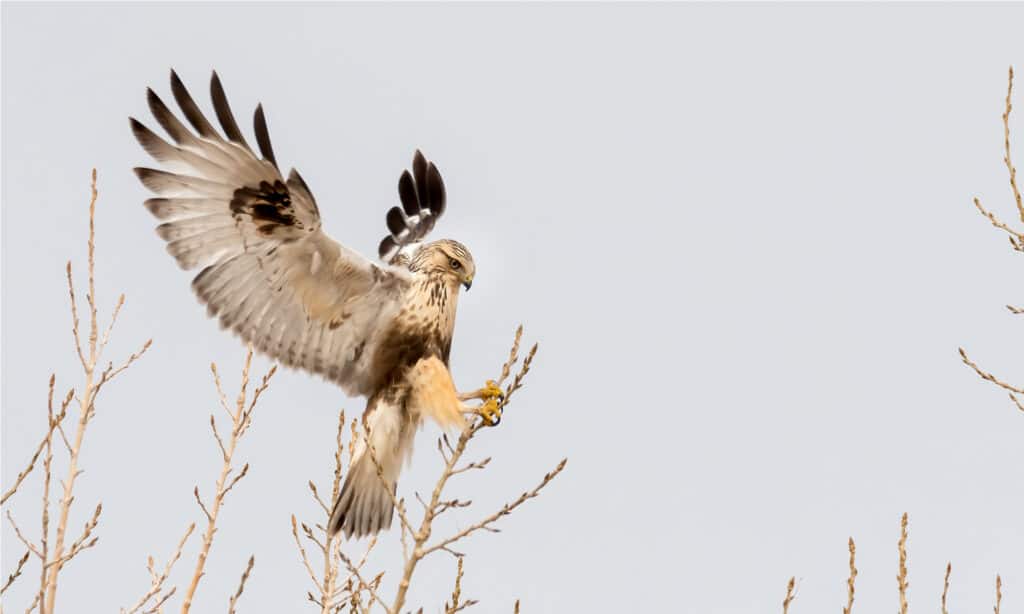
Rough-legged hawks have wide wings and wingtips that are usually swept back slightly from the wrist.
©Eivor Kuchta/Shutterstock.com
| Rough-legged Hawk | |
|---|---|
| Scientific name | Buteo lagopus |
| Color | Dark-brown |
| Weight | 1.32-3.66 lbs (599-1660 g) |
| Height | 18-24 in (46-60 cm) |
| Wingspan | 52-54 in (132-138 cm) |
Rough-legged hawks are not very common in New Jersey throughout the year. You can only spot them in winter. They can be sighted perched up on poles or hovering over open fields and marshes.
Rough-legged hawks have wide wings and wingtips that are usually swept back slightly from the wrist. They are dark brown with dark belly patches. They occur in light and dark morphs.
Rough-legged hawks have a diet that consists mainly of small rodents such as voles and lemmings. In winter, they breed in the arctic and migrate to open areas like deserts, prairies, and fields. Females lay 3-5 pale bluish-white eggs.
8. Northern Harrier

Northern harriers live in marshes, prairies, and the Arctic tundra.
©Harry Collins Photography/Shutterstock.com
| Northern Harrier | |
|---|---|
| Scientific name | Circus hudsonius |
| Color | Gray, white, black, and brown |
| Weight | 11-27 oz (300-750 g) |
| Height | 21-25 in (53-64cm) |
| Wingspan | 41-46 in (103-117 cm) |
Northern harriers are widespread in New Jersey all year. They can be easily sighted gliding low over grasslands or marshes. They are slender, medium-sized birds of prey with rounded tails and broad wings. They have distinctive owl-like faces.
Northern harriers feed on small birds and small mammals. They can also carry bigger prey like ducks and rabbits. They fly back and forth over the ground while watching and listening for small animals to prey on.
Northern harriers live in marshes, prairies, and the Arctic tundra. They conceal their nests on the ground, either in wetland vegetation or grass. Females lay 2-4 bluish-white eggs.
Summary of 8 Types of Hawks in New Jersey:
| Name of Hawk | Habitat | Prey |
|---|---|---|
| Northern Goshawk | Deepest parts of the forest. | Rabbits, doves, crows, squirrels, wood pigeons, and other birds. |
| Cooper’s | Woodland canopies | Quails, plump fowl, chickens, and smaller mammals. |
| Broad-winged | Deep woods. | Snakes, lizards, young turtles, frogs, and other small mammals. |
| Red-shouldered | Near wet forests; hover high along the coasts and ridges. | Reptiles, rodents, rabbits, crayfish, amphibians, and other small mammals. |
| Red-tailed | Comfortable in any habitat. | Moles, ground squirrels, rabbits, small raccoons, mice, and voles. |
| Sharp-shinned | Deepest ends of the forests. | Small birds like songbirds and quails; also large insects, snakes, frogs, squirrels, and rodents. |
| Rough-legged | Breed in the Arctic and migrate to open areas like deserts, prairies, and fields. | Small rodents like voles and lemmings. |
| Northern Harrier | Marshes, prairies, and the Arctic tundra. | Small birds and mammals but also ducks and rabbits. |
The photo featured at the top of this post is © Henk Bogaard/Shutterstock.com
Thank you for reading! Have some feedback for us? Contact the AZ Animals editorial team.







